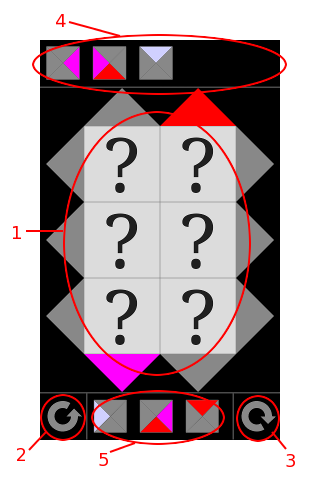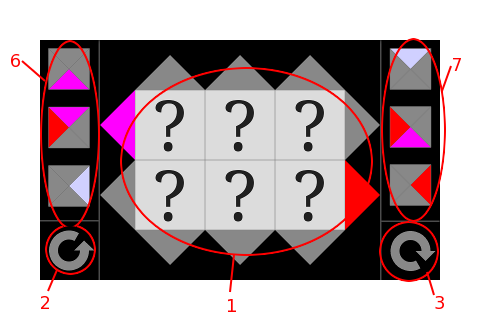Introduction
Car-Leur is a puzzle game; as any other puzzle game, the goal is to place a pieces at the correct place on the board. But in Car-Leur, the pieces are square (carré in french) tiles which are filled with colors (couleur in french).
The square shape and the colors of the tiles increase the difficulty of the puzzle because you can't use the edges of the pieces or its drawing to help you to find the correct place on the board.
The tiles
Each tile is divided into 4 triangles, each triangle is colored with one of 9 available colors. So each tile could have 4 triangles with the same colors, or 3 triangles with the same color and one triangle with a different color, or any other combination (see the table below for examples).
| One color tiles |  |
 |
 |
 |
 |
 |
 |
 |
 |
| Two colors tiles |    |
   |
   |
   |
   |
   |
   |
   |
   |
| Three colors tiles |   |
  |
  |
  |
  |
  |
  |
  |
  |
| Four colors tiles |  |
 |
 |
 |
 |
 |
 |
 |
 |
Other tiles: Two other types of tiles also exist: Bonus tiles and Unknown tiles. The Bonus tiles have one or more triangle which matches any color, it is symbolized with a rainbow. The Unknown tiles have one or more triangle which has only one color (one of the 9 colors) but this color is unknown and replaced with a ? (see the table below for examples).
| Bonus tiles | Unknown tiles | |
| One triangle |  |
 |
| Two triangles |   |
  |
| Three triangles |  |
 |
| Four triangles |  |
 |
The Board
 |
 |
The game layout is divided into different parts:
|
|
Playing
| Moving tiles from the tiles list or the puzzle board to the puzzle board | |
Option 1:
|
Option 2:
|
| Moving tiles from the puzzle board to the tiles list | |
|
|
| Rotating tiles | |
|
|
Solving the puzzle
To solve the puzzle, you should identify from the tiles list(s) the tiles to place on the board making each side of each tiles matching the color of the next tiles/border. Some examples of correct, potential and bad associations for the first tile are represented. |
||
| Good | Potential | Bad |
    |
    |
    |
    |
    |
    |
    |
    |
    |
Options
To improve the gameplay you can buy some options: